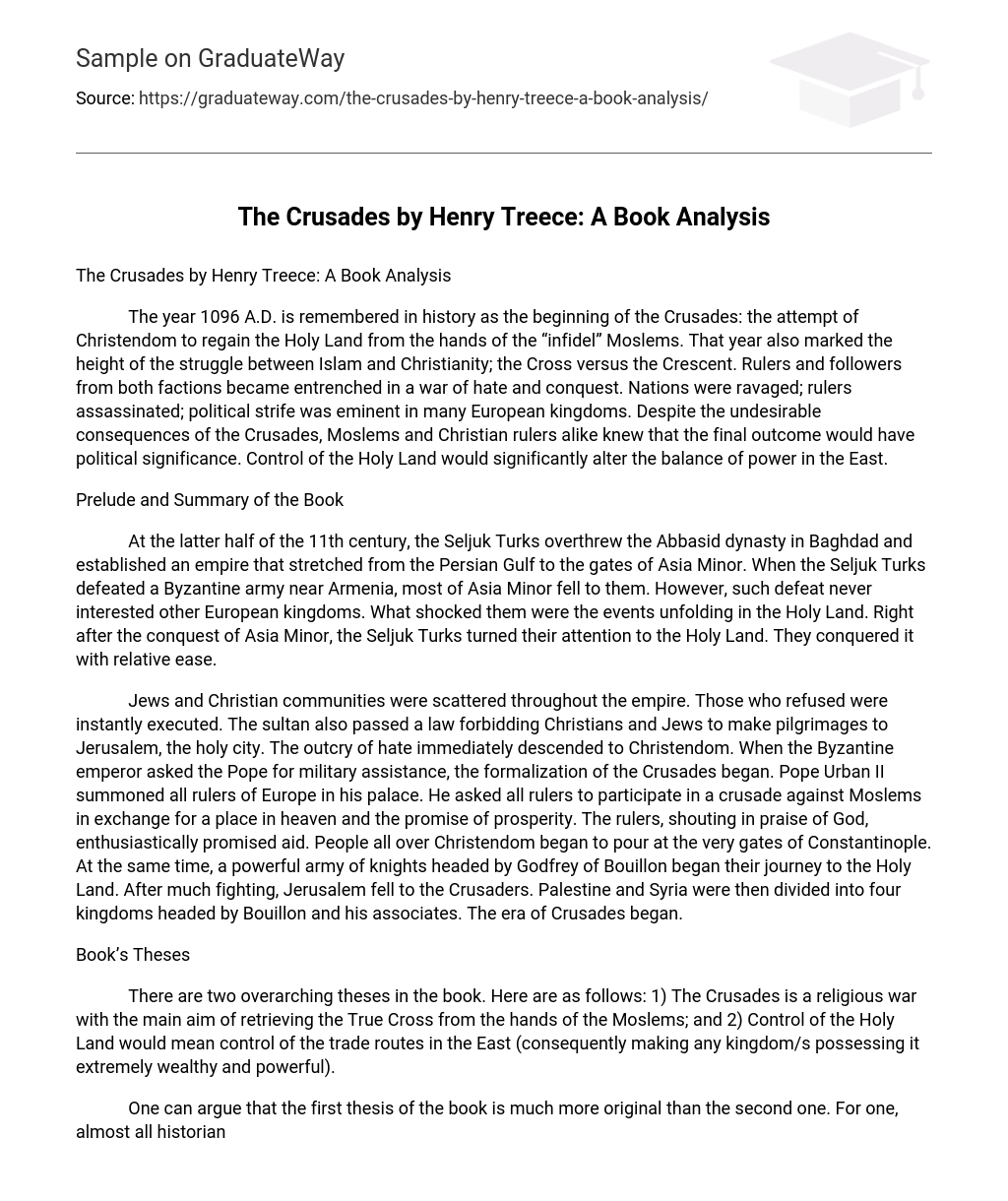The year 1096 A.D. is remembered in history as the beginning of the Crusades: the attempt of Christendom to regain the Holy Land from the hands of the “infidel” Moslems. That year also marked the height of the struggle between Islam and Christianity; the Cross versus the Crescent. Rulers and followers from both factions became entrenched in a war of hate and conquest. Nations were ravaged; rulers assassinated; political strife was eminent in many European kingdoms. Despite the undesirable consequences of the Crusades, Moslems and Christian rulers alike knew that the final outcome would have political significance. Control of the Holy Land would significantly alter the balance of power in the East.
Prelude and Summary of the Book
At the latter half of the 11th century, the Seljuk Turks overthrew the Abbasid dynasty in Baghdad and established an empire that stretched from the Persian Gulf to the gates of Asia Minor. When the Seljuk Turks defeated a Byzantine army near Armenia, most of Asia Minor fell to them. However, such defeat never interested other European kingdoms. What shocked them were the events unfolding in the Holy Land. Right after the conquest of Asia Minor, the Seljuk Turks turned their attention to the Holy Land. They conquered it with relative ease.
Jews and Christian communities were scattered throughout the empire. Those who refused were instantly executed. The sultan also passed a law forbidding Christians and Jews to make pilgrimages to Jerusalem, the holy city. The outcry of hate immediately descended to Christendom. When the Byzantine emperor asked the Pope for military assistance, the formalization of the Crusades began. Pope Urban II summoned all rulers of Europe in his palace. He asked all rulers to participate in a crusade against Moslems in exchange for a place in heaven and the promise of prosperity. The rulers, shouting in praise of God, enthusiastically promised aid. People all over Christendom began to pour at the very gates of Constantinople. At the same time, a powerful army of knights headed by Godfrey of Bouillon began their journey to the Holy Land. After much fighting, Jerusalem fell to the Crusaders. Palestine and Syria were then divided into four kingdoms headed by Bouillon and his associates. The era of Crusades began.
Book’s Theses
There are two overarching theses in the book. Here are as follows: 1) The Crusades is a religious war with the main aim of retrieving the True Cross from the hands of the Moslems; and 2) Control of the Holy Land would mean control of the trade routes in the East (consequently making any kingdom/s possessing it extremely wealthy and powerful).
One can argue that the first thesis of the book is much more original than the second one. For one, almost all historians would argue that the true purpose of the Crusades was the capture and control of Palestine for the much promised “wealth” and “power.” Some historians might argue that the Crusades were essentially a religious war. However, few or no historian would argue that the purpose (if not the whole purpose) of the Crusades was the retrieval of the True Cross of Christ.
Some of the evidences presented by the author are as follows:
1) The reigning pope asked the rulers of Europe to retrieve the Holy Cross from the Moslems. If the Crusaders fail, the promise of heaven might be delayed. At that time, the words of the pope were recognized as the “voice of God” (since he was the representative of Christ on earth). Thus, they were obeyed;
2) After the capture of Jerusalem, the search for the True Cross began the priority. Parts of the cross like the nails and the shaft were found and sent to Rome. The Crusaders were satisfied;
3) And, when Richard the Lion-Hearted (Third Crusade) began to negotiate with Saladin, the first thing he asked was the Holy Cross. Saladin would not concede to the demand of the English king because the Cross was not in his possession (Treece, 269).
Plausible the arguments may seem, there are things that the author forgot about the Crusades. First, the Cross was lost to the Moslems in the 7th century A.D. Christian rulers cared little about the Cross’ whereabouts. It can be said that the exhortations of Urban II only served to start the search of the Cross. The search for the Holy Cross was then the result not the purpose of the Crusades. And, the promise of wealth and salvation was the stimulating factor of the Crusades. Several historical documents prove this (as in the case of Toynbee, 273).
As to the form of the book, most of the events during the Crusades were clearly accounted. The reader can easily see the progression of events leading to the Crusades (and the aftermath). The only problem was the use of some historical materials that do not lend credence to the Crusades (like the life of Empress Helena). In any case, it seems that the author likes the subject he is writing. For example, in the book’s introduction he argued that the full account of the Crusades was his main interest (Treece, introduction viii). In general though, the book clearly covered almost all the events during the Crusades.
Works Cited
Toynbee, Arnold. A History of the World. New York: Harper Publisher’s Inc., 1989.
Treece, Henry. The Crusades. New York: Macmillan Publishing Company, 1962.





